Thermostat thermal protectors are essential components in a wide range of appliances and systems, serving the critical role of monitoring and controlling temperature to prevent overheating and potential damage. Among the various types of thermal protectors available, the “normally open” and “normally closed” variants are commonly used in different applications. In this article, we will delve into the world of thermostat thermal protectors, exploring their functionalities, applications, and differences.

Introduction to Thermostat Thermal Protectors Thermostat thermal protectors, also known as thermal switches or thermal cutouts, are devices designed to regulate temperature in electronic and electrical systems. These small yet crucial components are often found in appliances like ovens, refrigerators, and air conditioning units, as well as in industrial equipment such as motors and transformers. They serve as a safeguard against overheating, which can lead to component damage, fires, or system failure. The Basics: Normally Open and Normally Closed Thermal protectors come in two primary configurations: normally open (NO) and normally closed (NC). The fundamental difference lies in their electrical behavior when the temperature rises above a certain threshold: Normally Open (NO):In its default state, a normally open thermal protector maintains an open circuit. When the temperature exceeds the set threshold, it closes the circuit, interrupting power flow. This action effectively shuts down the equipment or system it is protecting, preventing further temperature rise. Normally open thermal protectors are often used in situations where safety is paramount, as they offer immediate and decisive protection against overheating. Normally Closed (NC):Conversely, a normally closed thermal protector remains in a closed circuit state at rest. It only opens the circuit when the temperature surpasses the predefined limit. This interruption in power serves as a signal to the system controller, alerting it to the overheat condition. Normally closed thermal protectors are commonly used in applications where monitoring and early detection of temperature anomalies are crucial, allowing for timely intervention and maintenance. Applications of NO and NC Thermostat Thermal Protectors The choice between normally open and normally closed thermal protectors depends on the specific requirements of the application. Let’s explore some typical scenarios: Oven Temperature Control:In an electric oven, normally open thermal protectors are employed to ensure immediate shutdown if the temperature exceeds safe limits. This rapid response prevents food from burning and reduces the risk of fire. Motor Protection:Industrial motors often use normally closed thermal protectors. These protectors allow continuous monitoring of the motor’s temperature. If an overheating situation arises, the thermal protector opens the circuit, triggering an alarm or initiating a shutdown sequence to prevent motor damage. Refrigeration Systems:Normally closed thermal protectors are used in refrigerators and freezers to monitor the compressor’s temperature. If the compressor gets too hot, the protector opens the circuit, signaling the need for maintenance before the system fails. HVAC Systems:Both normally open and normally closed thermal protectors find applications in heating, ventilation, and air conditioning systems. Normally open protectors may be used to prevent overheating, while normally closed protectors provide continuous temperature monitoring. Conclusion Thermostat thermal protectors, whether normally open or normally closed, play a vital role in maintaining the safe and efficient operation of various appliances and industrial equipment. The choice between these configurations depends on the specific requirements of the application, with normally open protectors offering immediate protection and normally closed protectors providing continuous monitoring. Understanding the differences between these two types of thermal protectors is essential for ensuring the safety and reliability of the systems they safeguard.